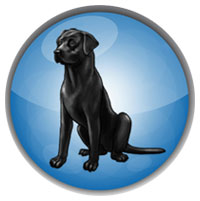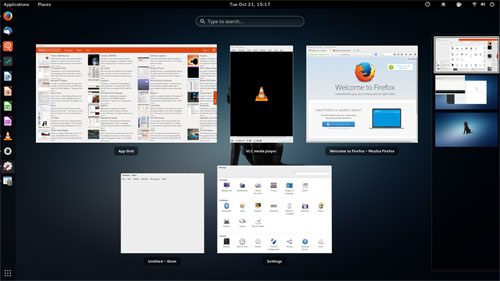
![]()
Black Lab Linux is a general purpose free distribution for home users and small-to-mid-sized businesses. This particular segment of the Linux OS tries to bridge free OS and preconfigured commercial hardware/software with a flexible set of options.Black Lab Linux is an outgrowth of OS4 OpenLinux, a distro released in 2008 by the same developers. There is a blurred line between the free community version and Black Lab Software’s Enterprise Linux release.
Both the community and the commercial releases could be a great alternative for personal and business users who want to avoid buying a computer off the shelf and struggling to install Linux with Microsoft Windows and the Unified Extensible Firmware Interface, or UEFI, horrors.
I preferred earlier versions of Black Lab Linux running the Xfce desktop. I was less impressed with the latest iteration I reviewed, Version 6 Beta 2, released on Sept. 28. It is available only in a 64-bit tweaked GNOME 3 desktop offering. The final release, slated for Nov. 1, will complete the changeover to GNOME 3.
Philosophical Differences
Black Lab Linux is switching to GNOME 3 as the primary user interface. That decision was based on several imperatives, according to the developer blogs.
One, the Xfce desktop community has not issued updated desktop releases since 2012. Two, Black Lab Linux’s developers want to avoid the consternation that comes from forking a lagging open source project. So, moving beyond Xfce was necessary to provide new features in Black Lab Linux.
GNOME 3 was the only desktop environment that met the Black Lab Linux developers’ targeted list of 30 criteria. So the community version developers tweaked the GNOME 3 shell to reduce its resource consumption and ensure compatibility with all of its extensions.
Limited desktop options will be available, depending on whether the community or enterprise versions are used. For example, enterprise users who subscribe to custom builds will continue to have Xfce as a fee-based option. The company’s education customers will continue to get Xfce as the primary desktop with GNOME as an option.
However, the Xfce release will have a modified look to include a unique deskbar feature. This makes the desktop more intuitive and functional. The GNOME 3 desktop environment is the new default for the all other users.
Look and Feel
There are no distinguishing features that make Black Lab Linux stand out from the glut of Linux distros. The tweaked performance of GNOME 3 is a nice touch in Black Lab Linux.
Otherwise, this distro is much the same as dozens of others with GNOME 3 or even Xfce environments. Linux users above the newbie category will find very little to separate the latest Black Lab Linux release — either the GNOME or the Xfce version — from the dozens of distros claiming to offer the ideal Microsoft Windows replacement.
I tend to avoid the GNOME flavor in favor of almost any other option except Ubuntu’s Unity edition. However, that is my preference. That said, the tweaking the Black Lab Linux developers did with the GNOME 3 desktop makes using it much more appealing to me.
Clean View
The screen layout is designed to maximize working space and minimize clutter. The panel at the top of the screen is just narrow enough to display the necessary notification icons and running application labels.
The left side of the panel holds a Places launcher that drops down a list of key locations. The Applications label opens a two-column display. The first column lists the categories. The other shows the programs.

An Activities Overview label on the bottom of the left menu column shows a Scale view of running applications and slides out from the right edge of the screen a thumbnail view of the virtual workspaces. Click the desired thumbnail to move to that workspace.

The left edge of the screen holds the vertical Favorites bar. This only slides into view when you place the mouse pointer at the left edge of the screen.
A button at the bottom of the Favorites bar launches the full screen list of installed applications. You can click a button on the bottom to show all programs or frequently used apps. A vertical row of buttons on the right edge of the menu display lets you page through the listing.
User Appeal
I like the integration of the tweaks into the GNOME 3 interface. Black Lab Linux’s approach takes much of the drudgery out of using GNOME.
For example, the keyboard shortcuts are easily edited to let me switch among open workspaces with fingertip control. Even the mousing method of navigating menus and workspaces is much more convenient. Pressing the super key opens the Scale view and slides out the workplaces thumbnails panel.
One aspect of the otherwise smooth GNOME 3 tweaking is the missing Expo feature. When multiple windows applications are running in a single virtual workspace, the Scale view is handy. However, when multiple workspaces are in play, there is no Expo view to show all running programs at a glance.
Software Supply
Black Lab Linux leaves users with little in the way of missing software. This is especially important to Linux newcomers.
The collection of titles is impressive. The software packages include some of the best office, graphics and media software provided by open source developers.
To add software, however, you must use the Synaptic Package Manager. This distro lacks its own software repository.
Another salient point is the use of Ubuntu software repositories for system updates. Black Lab Linux is based on Ubuntu 14.04.
Software by Extension
Extension packs offer functionality that is not included in the base Black Lab Linux system. Some of these add-on packs are created by the developers.
Other offerings come from user-contributed extension packs released under the terms of the LGPLv3 and GPLv2 licenses.
Be prepared to contribute your cash to add some of these features. Some of the extension packs are provided by PC/OpenSystems, Black Lab Software’s enterprise division. They can be ordered for system integration, and are covered by support subscriptions and multiseat licensing.
Bottom Line
Black Lab Linux is a reasonably good distro for everyday personal use and light business computing. Its use of a modified GNOME 3 desktop environment provides a pleasant user experience.
However, the developers have yet to give any indication on the features they plan to add to upcoming releases to justify switching to GNOME 3 over Xfce. One option they seriously should consider is providing users with a better choice of desktops. Otherwise, they will be reinventing the wheel or waiting for GNOME 4 to bring better features.
Want to Suggest a Review?
Is there a Linux software application or distro you’d like to suggest for review? Something you love or would like to get to know?
Please email your ideas to me, and I’ll consider them for a future Linux Picks and Pans column.
And use the Talkback feature below to add your comments!





















































